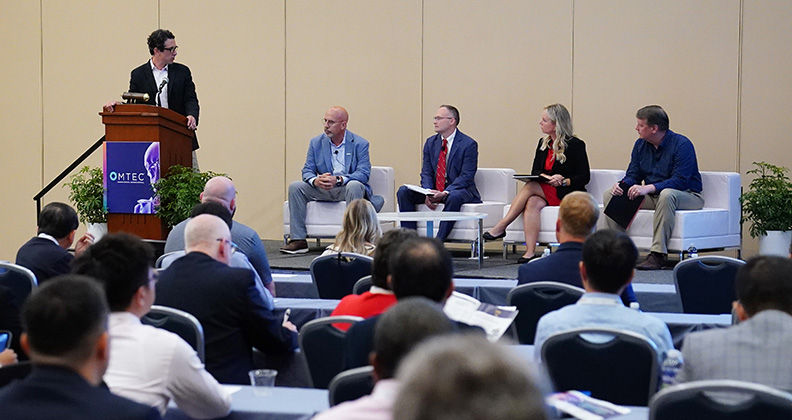
Innovation is the means by which all companies bring ideas and technologies to market. It’s the central driving force for discovery, advancement and problem-solving, building upon prior knowledge and experience to think of new ways to create products, techniques, processes and solutions. The orthopedic industry leverages innovation as it strives to continuously improve patient outcomes.
As part of our OMTEC virtual education series, we spoke with Doug Leach, Managing Director of Device Innovation at HSS Innovation Institute, about ways in which the organization has internally fostered a culture of innovation by leveraging people, strategy and technology.
Leach, who spent decades leading teams in the orthopedic industry before moving to HSS, identified several key takeaways that we found insightful and applicable to orthopedic innovators everywhere.
1. Prioritize Projects
Sometimes idea lists can get overwhelming. When deciding which programs and projects to move forward with, HSS looks at financial and resource metrics to determine what they’re capable of working on, and they choose to focus on ideas aligned with their mission.
For instance, in most organizations, the bottom line is considered in project prioritization. HSS takes it a step further by adding a second bottom line that is mission-based. Sometimes a program gets green-lighted because it aligns with HSS’ mission to improve patient care and solve critical issues, but it might not meet the goals of the financial bottom line.
“We go through a very deliberate decision process, and we have quite a number of advisors that we work with that ultimately give us insight that will help us decide how we prioritize one thing over another,” Leach said. “Once we make a decision, we move forward with it.”
Advice: Prioritizing projects and product pipelines is easier when you have a clearly defined vetting process. Having a clear understanding of how decisions are made can free teams to innovate.
2. Utilize Untapped Resources
At HSS, a New York City-based hospital, space is at a premium. Operating rooms and inventory rooms are packed, and the process by which they move patients through the hospital has to be well thought out and efficient.
HSS developed an in-house resource called the Operational Excellence Team, a group of industrial engineers and data scientists that drive operational efficiency within the institution.
“They combine those two very interesting, complementary skill sets to come together and work to make HSS work very well,” Leach said. “But that’s a resource that could be leveraged by pretty much any other provider that’s out there, and for any industry partner that may be working on a new procedure, or a new clinical indication, or looking for ways to improve overall operating room flow with their current systems.”
HSS also utilizes a Value Team, a group of economists, physicians and researchers who look at the operation of the hospital from an overall value perspective. This helps the organization know what adjustments should be made or whether to focus more on reimbursement or cost-cutting or cost-spending. The team assists HSS in its delivery of value for specific procedures and the overall healthcare economy.
Advice: OEMs should leverage the work of these teams at HSS and other hospital systems as they’re developing products. The example also calls for OEMs to find ways to cross-collaborate within their organizations to advance their processes and goals.
3. Develop and Deploy Data
Data has always been key to making informed decisions, and that’s the case as well when it comes to innovation. Large amounts of data can be used to identify patterns, gaps and trends that spark creativity.
“The technology we are strongly adopting now, and we’re seeing this as a common thread throughout the provider space, is getting our arms around the data analytics piece,” Leach said. “Every hospital has a ton of data even within its own EHR system. We are learning very quickly, with tools at our disposal, how to leverage that data, how to slice or dice it so that it provides a meaningful output to us to help us make decisions.”
On the longer-term side of things, predictive modeling has the HSS team’s attention.
“The world of sensors is exploding. The world of motion analysis is exploding. The world of imaging has always been a very significant technology, but even that is beginning to advance further and get better and better,” Leach said. “You’re seeing CT scanners and MRI scanners these days that can eliminate the metal artifact from a patient who might have an implant. It’s almost not even a problem.”
HSS is stitching all of that information and innovation together to develop a “digital twin” of a patient. This digital twin is created through initial inputs collected from patient symptoms and simple preoperative motion exercises leveraging sensors, putting it all into a predictive model.
“The predictive model could then guide how the surgeon positions an implant intraoperatively and guide the rehabilitation of the patient downstream,” Leach said. “That’s very exciting to us and has a huge amount of promise moving forward.”
Advice: All organizations amass data. Companies that can prioritize utilizing that data will find new ways to innovate within their organization and for their customers.
4. Collaborate with External Partners
There’s a lot of value in the proximity of technology to the point of care itself, and for HSS, that was one of the critical drivers for having onsite manufacturing. They have recently partnered with LimaCorporate, a global leader in 3D design and printing of personalized components for orthopedic patient care, to open the first design and additive manufacturing 3D printing facility for custom complex implants on a hospital campus.
“We are doing more and more highly complex joint replacements that require highly complex implant systems that you can only get through a custom route through any of the current companies,” Leach said. “That route is partially because of regulatory challenges, partially because of design challenges, but also partly because of geographic challenges.”
The long route translates to weeks and months that a patient might wait for an implant. Onsite manufacturing gives HSS the ability to shorten that wait time for patients and improve the design and development of the implant process. The idea was to take something that is becoming more prevalent in their practice (onsite manufacturing) and cut down the timeline while increasing the quality and likelihood that they’ll get the implant and complex procedure right the first time.
“With the partnership we have with Lima and the expertise they have with 3D printing, we saw a lot of value in trying to bring that technology onsite, whereby now our surgeons can literally walk a block and a half and meet with the engineers from the studio to talk through their clinical needs, can work with the HSS department of biomechanics and the development engineers that are there, partner to come up with the best solution for the patient, and then go ahead and fabricate that implant onsite. If there are issues, they can respond to them quickly,” Leach said.
Advice: You might identify a challenge, but not have the internal resources to overcome it. Collaboration with external partners that possess the expertise you seek is an intelligent way to advance innovation within your organization.
Orthopedic OEMs have demonstrated a passion for innovation for decades. Driving a culture of innovation requires collaboration internally and externally to truly advance your ideas. As someone who spent years leading teams at orthopedic OEMs and now works for a provider, Leach recommends that industry ask and learn from their surgeon and hospital customers. After all, innovation can’t take place in a vacuum.
“These experiences, these people and these amazing feats they have achieved, being part of a provider are things that industry, and quite honestly all of us, can really learn from and could move orthopedics along at a much quicker pace,” Leach said. “It’s one of my encouragements for everybody to keep that in the back of your mind as you’re planning your next project or thinking through the next market opportunity that you want to go after.”
HT
Heather Tunstall is a BONEZONE Contributor.




